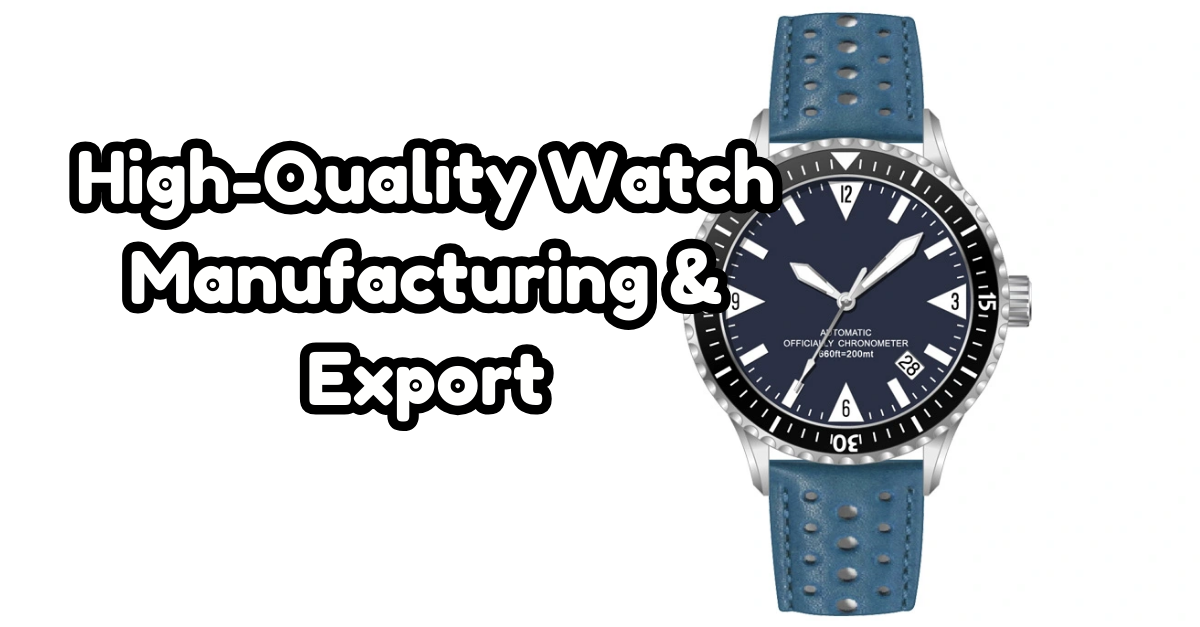Introduction: The Evolution of the Watch Industry
The watch industry has undergone a remarkable transformation over the past few decades. No longer confined to local markets, high-quality watch Visit our website manufacturing and export have reached global proportions. As technology advances and consumer preferences evolve, watch manufacturers must adapt to a rapidly changing landscape. This article explores the critical components of high-quality watch manufacturing and its implications for global export, emphasizing the importance of craftsmanship, innovation, and market strategy.
In a world where timepieces are not merely functional but also serve as fashion statements and status symbols, the demand for unique, high-quality watches has surged. Brands are now tasked with meeting this demand while ensuring that their products maintain the highest standards of quality and precision. The journey of a watch from conception to global distribution encapsulates a fascinating blend of art and science.
Craftsmanship: The Foundation of Quality
At the heart of high-quality watch manufacturing lies the craftsmanship that defines each timepiece. Skilled artisans dedicate their lives to perfecting the art of watchmaking, utilizing techniques that have been honed over generations. This level of expertise ensures that every component, from the intricate movement to the case, is crafted to perfection.
The manufacturing process begins with the careful selection of materials. High-quality metals, durable crystals, and premium leathers are sourced to ensure longevity and aesthetic appeal. Each piece undergoes a meticulous assembly process, where skilled watchmakers ensure that every detail is attended to, resulting in a product that is both functional and visually striking.
Moreover, the significance of craftsmanship extends beyond aesthetics; it directly impacts the performance and durability of the watch. A commitment to high-quality standards translates into timepieces that can withstand the test of time, which is crucial in building brand reputation and consumer trust.
Technological Advancements: Shaping the Future of Watchmaking
The integration of technology in watch manufacturing has revolutionized the industry. Automation and advanced machinery enable manufacturers to achieve levels of precision that were previously unattainable. Computer-aided design (CAD) software allows for intricate designs and rapid prototyping, ensuring that the final product aligns with the brand’s vision and quality standards.
In addition to enhancing production efficiency, technology plays a crucial role in quality control. Automated inspection systems can detect defects that may go unnoticed by human eyes, ensuring that only flawless products reach the market. This level of precision not only bolsters a brand’s reputation but also minimizes costly returns and repairs.
Furthermore, the rise of smartwatches has prompted traditional watchmakers to innovate. By integrating modern technology with classic designs, manufacturers can appeal to a broader audience while maintaining their heritage. This adaptability is vital for staying competitive in an ever-evolving market.
Global Distribution: Expanding Market Reach
As high-quality watches gain popularity worldwide, manufacturers must develop effective global distribution strategies. Navigating the complexities of international trade can be challenging, but establishing a strong distribution network is essential for reaching diverse markets.
Successful watch manufacturers often partner with experienced logistics providers to streamline the export process. These partnerships facilitate smooth shipping, customs clearance, and delivery to customers around the globe. By optimizing logistics, manufacturers can ensure that their products are available to a wider audience, ultimately increasing sales and brand visibility.
Understanding regional market dynamics is equally important. Each market has its unique preferences and regulatory requirements, necessitating tailored marketing strategies. Manufacturers must conduct thorough research to align their offerings with local tastes, ensuring that their watches resonate with consumers in different regions.
Marketing Strategies: Building a Global Brand Identity
Effective marketing is crucial for establishing a global brand identity in the competitive watch industry. As consumers become increasingly discerning, brands must convey the quality and craftsmanship behind their products. Storytelling is a powerful marketing tool that allows manufacturers to connect with consumers on an emotional level.
Brands can showcase the heritage and artistry involved in watchmaking through compelling narratives that highlight the journey of each timepiece. Utilizing social media platforms and influencer partnerships can also amplify a brand’s reach and visibility. By sharing high-quality content that showcases their products, manufacturers can engage with potential customers and foster a loyal community.
Participating in international trade shows and exhibitions offers additional opportunities to enhance brand presence. These events allow manufacturers to showcase their latest collections, connect with industry professionals, and gain insights into emerging trends. By actively engaging in the global watch community, brands can solidify their status as leaders in the market.
Sustainability: A Growing Concern in Watch Manufacturing
As consumers become more environmentally conscious, sustainability has emerged as a critical factor in watch manufacturing. High-quality watch brands are increasingly adopting eco-friendly practices to minimize their environmental impact and meet consumer demand for sustainable products.
This commitment to sustainability can take many forms, from sourcing materials responsibly to implementing energy-efficient production processes. Manufacturers that prioritize sustainability not only contribute to the preservation of the planet but also enhance their brand reputation. Consumers are more likely to support brands that align with their values, creating a competitive advantage for those committed to sustainable practices.
Moreover, transparency in sourcing and production can build trust with consumers. Brands that openly communicate their sustainability efforts are more likely to attract a loyal customer base. By integrating sustainability into their business models, watch manufacturers can thrive in a market that increasingly prioritizes ethical consumption.
Challenges in Global Watch Manufacturing and Export
Despite the promising opportunities in high-quality watch manufacturing and export, several challenges must be addressed. The global market is fraught with competition, making it essential for brands to continually innovate and differentiate themselves. Additionally, fluctuating exchange rates, tariffs, and trade regulations can impact profitability and complicate the export process.
Supply chain disruptions, particularly those exacerbated by global events such as pandemics, can also hinder manufacturing operations. To mitigate these risks, manufacturers must develop resilient supply chains and establish contingency plans that allow them to adapt to unforeseen challenges.
Moreover, as brands expand their global reach, maintaining consistent quality across all markets becomes increasingly complex. It is crucial for manufacturers to ensure that their quality control processes are uniform and that they adhere to the same high standards, regardless of where their products are being sold.
Conclusion
The future of high-quality watch manufacturing and export is filled with promise and potential. As brands navigate the complexities of a global market, they must prioritize craftsmanship, innovation, and sustainability to meet the evolving demands of consumers. By integrating advanced technologies and optimizing distribution strategies, manufacturers can expand their reach and enhance their brand presence worldwide.
Moreover, embracing sustainability and transparency will be crucial in building trust with consumers, ensuring that high-quality watches are not only desirable but also ethically produced. The path forward requires a commitment to excellence and adaptability in the face of change.
As the watch industry continues to evolve, manufacturers that prioritize quality, innovation, and sustainability will thrive in the global marketplace. The blend of tradition and modernity, craftsmanship and technology, will define the future of watchmaking, offering consumers exceptional timepieces that reflect their individuality and values. Through dedication to these principles, the watch industry can ensure its legacy while paving the way for a vibrant and sustainable future.



